Part 2 of A Pilgrimage Journal.
(Journal Entry One, Two, Three, Four, Five)
"Imagine having your birthday on the Camino!"
That had been the standard response whenever I’d told people at home that I’d be spending my birthday in Spain, and indeed from other pilgrims in the first couple of weeks of walking. Now, though, I can’t help but laugh at this, as among the nine of us who would eventually grow together as a Camino family, five of us celebrated our birthdays on the Way. Mine started at Los Arcos, with two Germans singing "Happy Birthday to You" over breakfast.
I set off from the main square with Leah who returned the walking pole she’d been using over the previous couple of days now that she’d bought her own. Equipped with two again, I was surprised to find that my walking rhythm had changed so that my poles were now a constant help rather than a frequent hindrance. There’s a technique to walking with poles, and now that I’d somehow mastered it, I moved faster than I’d done all week.
By noon we’d covered twenty kilometres, and shortly after lunch we reached Logroño, gazing at the rooftop storks that would soon be a commonplace of the Camino. It wasn’t long before we were settled into our albergue. In the courtyard we chatted with a cheerful trio of New Zealanders, and at our bunks met the Tennessee medical students we’d spotted just after Roncesvalles, saying their Office by the side of the road.
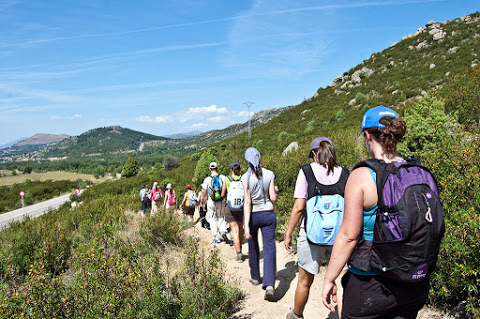
Jesus Perez Pacheco
As afternoon turned into evening I marvelled at the agonisingly realistic crucifix in the church across the street before meeting Leah. After much clandestine effort, she had found a shop where she could buy a birthday cake, so I was suitably abashed and delighted when it was produced in the albergue kitchen to a multi-national chorus of "Happy Birthday to You". After dinner we bumped into a few other pilgrims and though we’d rather less than an hour until our curfew, we made it count amongst the wonderful tapas bars of Travesia del Laurel.
The next day, unfortunately, was a long, dreary trudge under cloudy skies, with the vineyards of La Rioja making for oddly monotonous scenery. The longest day thus far, it was also one that saw me bordering on hypothermic shock when my body temperature dropped after I stopped moving and took my boots off at Nájere’s barracks-like municipal albergue. Huddling for warmth in my sleeping bag helped a bit, though I was later told I was barely coherent when speaking over the next hour. Among other things I’d become distraught about losing my credencial, the "pilgrim passport" that bore stamps marking everywhere I’d stayed, though it was beside me the whole time. Eventually I emerged and shuffled outside for dinner. Hot Spanish red bean stew, it turned out, was just the cure I needed.
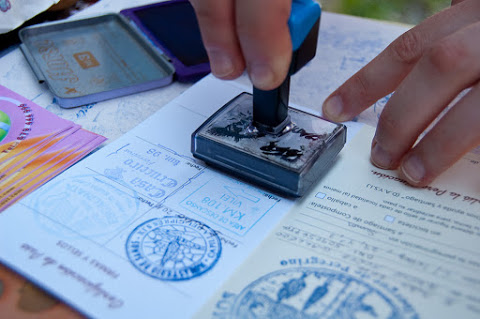
Jesus Perez Pacheco
Santo Domingo de Calzada, the following day’s destination, takes its name from a local saint who in the eleventh and early twelfth century dedicated himself to helping pilgrims and improving the local stretch of the Camino. The walk there was tedious and grey, marred by a frequent drizzle, but annoyances on the journey were more than made up for by that evening’s pilgrim Mass in the cathedral. The ceremony was almost dazzling in its beauty, and a wonderful concert afterwards rounded out the evening in style.
Once the concert was over we were gently but firmly ushered out, denying me the chance to see the chicken and rooster that live within the cathedral in a gilded coop, a bizarre reminder of the most famous – and surely most peculiar – miracle tale associated with the Camino. The story goes that a fourteenth-century German youth, passing through the area on his way to Santiago, was framed for theft and hanged. His grieving parents continued their pilgrimage, and on returning were astonished, as one would expect, to find their son still dangling from a tree and quite alive. He told them that Saint James had interceded to save his life, and so they rushed to tell the local mayor. The mayor, who was eating his dinner, snorted that their son was no more alive than the rooster and chicken which he’d been eating, at which point the two birds leapt from the plate and began to squawk and dance!
In St. Jean I’d been advised against walking with the same people for my entire Camino, and indeed, the wisdom of that had become apparent by the time I reached Santo Domingo. New additions to the group had changed the dynamic, making our pilgrimage more of a macho charge. The emphasis seemed wholly upon getting ahead, with no sense of the moment, so I decided to head off on my own, thinking it was time to have the Camino I’d expected.
That didn’t happen, of course. No sooner had I said goodbye to Leah, when I started talking with the New Zealand trio I’d met in Logroño and ended up joining two of them, Hannah and Jeremy, in walking Jeremy’s limping sister Bryony to the bus stop before setting off on what would feel one of the easiest walking days of the Camino.The steeple-punctuated landscape itself coaxed us along. Hardly had we left one village when another loomed in sight, its church visible from afar, assuring us that we didn’t have far to go.
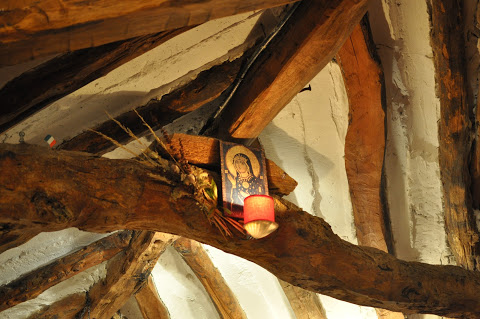
Greg Daly
At Tosantos we stayed in a simple Franciscan albergue, sharing a communal meal with the other pilgrims and joining them in a prayer session where Bible passages and hymns were linked with the personal prayers of previous pilgrims. If any of us cared to leave prayers behind, we were told, they too would be read aloud and prayed over for the twenty further days it would typically take us to get to Santiago. Hymns eased us into a less formal singsong, where a Frenchman named Paschal took the helm, producing a miniature guitar and a tiny laptop to lead us in songs in languages as diverse as Polish and Basque. It was past eleven when I finally curled up on my attic mattress, glowing with delight at how the day had gone. It was as though my Camino had dramatically shifted gear.
The next day was beautiful, with wheatfields and tiny villages giving way to wooded hills leading us down to the tiny hamlet of San Juan de Ortega, named after St. John of the Nettles, a student of St. Dominic of the highway. The village had once been a thriving pilgrim center, but over the centuries had fallen into disrepair. Now little more than a restored church with some beautiful Romanesque carvings, an enormous monastery largely converted into a rudimentary albergue, and a bar, there’s little else to do but sit outside and chat over drinks. We took advantage of the weather to do just that, exchanging stories of our Pyrenean crossings while Jeanne kept us up to date on the breaking news of King Juan Carlos’s abdication.
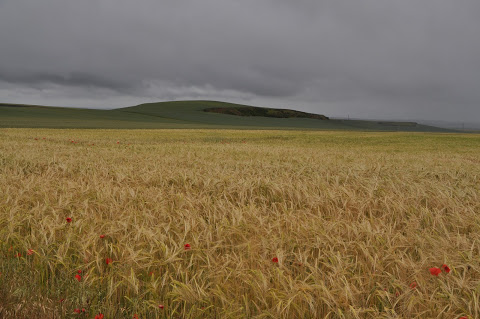
Greg Daly
These conversations seemed different from ones earlier on the Way. The standard pilgrim opening, "Where are you from?" had been joined by, "When did you start?" It wouldn’t be too long before the rather trickier question, "Where did you start?" would complete the roster. The simple answer to that was always, for me at least, St. Jean Pied de Port, just as others would say Roncesvalles or Logroño or in one memorable case Geneva; it just meant "this is where I started walking from."
I wasn’t sure the simple answer was the best one, though. A medieval pilgrim would always have held that he started his Camino at his front door, and there are some who’d hold that you start your Camino wherever you decide to walk to Santiago, which in my case had been in Cork a few months earlier, after it had become clear that the life of a Dominican friar wasn’t for me. In truth, though, it had been while I sat in Paris’s church of Saint-Paul-Saint-Louis a few days before I started walking that it really hit me that what I was about to do was very definitely a pilgrimage. It seems absurd to say that now, but it was only after visiting Chartres and walking on the very stones on which countless pilgrim predecessors had prayed and slept over the centuries that the reality of the Camino began to sink in for me.
Eventually, after a simple pilgrim blessing in the church and dinner in the bar, we headed to bed early, giggling ourselves to sleep amongst the dormitory’s symphony of snores.
If the way to San Juan had been idyllic, the path to Burgos proved anything but, with the last eight kilometres to the town being through industrial estates. The following day several embarrassed pilgrims admitted that they’d covered that stretch by bus, and I responded by saying that I didn’t blame them.
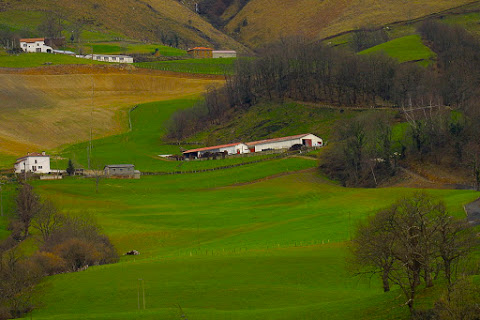
Alfredo Miguel Romero
Burgos’s main albergue was full by the time we met Bryony and her English friends in a bar in the centre of town, but it wasn’t long before we were offered a large room in a cheap hotel. Mass and a pilgrim blessing in the huge cathedral where El Cid is buried was followed by dinner and a night out, as we took advantage of the lack of a curfew and the fact that the following day was a rest day.
I’d hoped to visit St. Dominic’s birthplace on the rest day, as a kind of personal pilgrimage, but though Calleruega wasn’t far away and getting there was quite possible, it was clear that getting back would be far too difficult. Forced to shelve that idea, I spent the day lazing about Burgos instead. After Mass that evening we were joined for a spectacular dinner by pilgrims who’d arrived that day, including both Leah and Dave and Christa who I’d not seen since Los Arcos.
Predictably it turned out to be a late night, culminating in our raucous chorus of "I would walk five hundred miles" in an otherwise empty bar. In hindsight, that probably wasn’t the best preparation for what would be our first day on the Meseta.
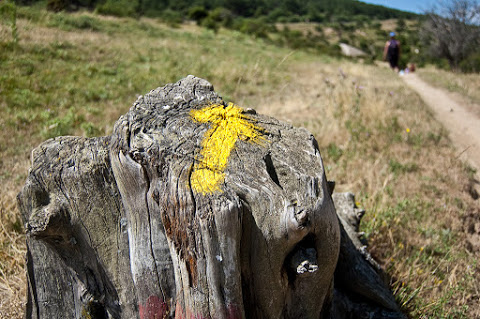
Jesus Perez Pacheco







